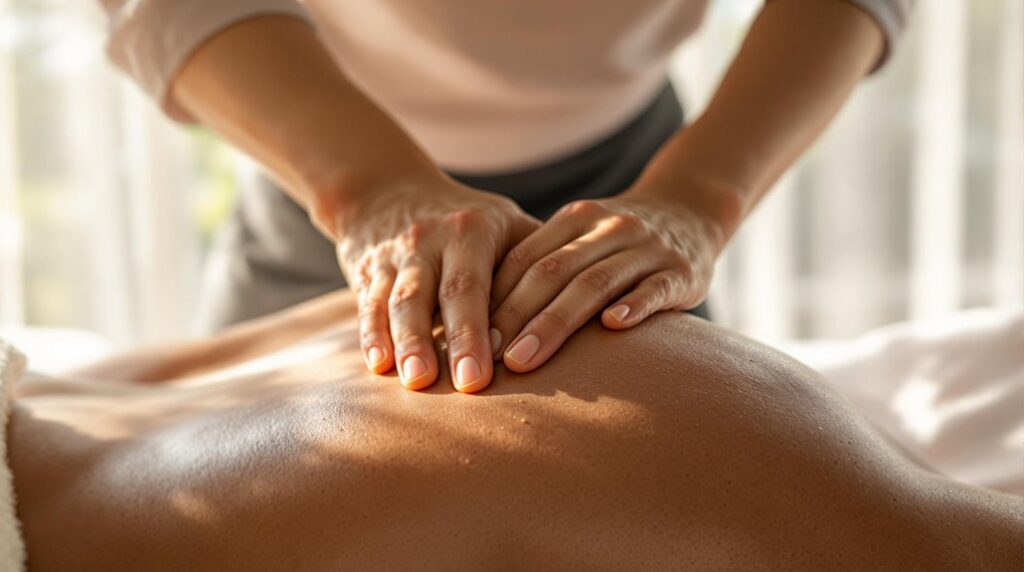Sports massage relieves chronic pain through multiple physiological mechanisms. When you receive a massage, it increases blood flow to muscles while triggering endorphin release, your body's natural painkillers. The pressure applied interrupts pain signals to your brain through mechanoreceptor stimulation, while specific techniques break down adhesions and scar tissue. Regular sessions improve circulation, flexibility, and muscle resilience, with benefits amplified when combined with other therapeutic strategies. Understanding these techniques can transform your approach to pain management.
Understanding the Science Behind Sports Massage and Pain Relief
Although scientists are still uncovering the complex mechanisms behind sports massage's effectiveness, research has shown that it can considerably reduce chronic pain through several physiological processes. When you receive a sports massage, you'll experience increased blood flow to your muscles, which helps remove metabolic waste and deliver oxygen-rich nutrients. You'll find that the manipulation of soft tissues triggers your body's release of endorphins, your natural pain-killing hormones, while simultaneously reducing levels of stress hormones like cortisol. The pressure applied during massage also stimulates your mechanoreceptors, effectively interrupting pain signals to your brain. Additionally, you'll benefit from the breakdown of adhesions and scar tissue, which can improve your range of motion and decrease persistent discomfort in problem areas. This approach not only enhances movement efficiency but also plays a key role in preventing future injuries.
Key Sports Massage Techniques for Managing Chronic Pain
When treating chronic pain through sports massage, practitioners rely on several essential techniques that target specific physiological responses in the body. You'll find that these methods work together to reduce inflammation, increase blood flow, and release muscle tension. Each technique serves a distinct purpose in pain management and rehabilitation. Additionally, the integration of soft tissue therapy enhances the effectiveness of these techniques by addressing underlying muscle issues.
| Technique | Primary Benefits |
|---|---|
| Effleurage | Improves circulation, relaxes muscles |
| Petrissage | Breaks down adhesions, releases tension |
| Friction | Targets deep tissue, reduces scar tissue |
These techniques, when applied correctly, can help you manage various types of chronic pain conditions. Your therapist will likely combine them in a specific sequence, adjusting the pressure and duration based on your pain levels and tissue response. The key is consistent application and proper technique to achieve lasting relief.
Targeting Specific Pain Points Through Sports Massage Methods
To effectively address chronic pain conditions through sports massage, practitioners must identify and target specific trigger points within the affected muscle groups. You'll find that these points often manifest as tight knots or areas of tension that can refer pain to other parts of your body. When you're experiencing chronic pain, your therapist will use specific techniques like deep tissue work and myofascial release to target these areas.
You can expect your massage therapist to focus on common trigger points in your upper trapezius, levator scapulae, and rhomboids if you're dealing with neck and shoulder pain. They'll apply sustained pressure to these spots while incorporating movement patterns that help release muscle adhesions and improve circulation to the affected areas. Additionally, sports massage plays a crucial role in enhancing recovery time and overall performance, making it a valuable treatment for athletes experiencing chronic pain.
Long-Term Benefits of Regular Sports Massage for Pain Management
While immediate pain relief remains a primary goal of sports massage, the long-term benefits offer even more compelling reasons to maintain regular sessions. You'll notice improved circulation and flexibility that can prevent future pain episodes, while your muscles develop better resilience against daily stress and strain. Regular treatments will help break down scar tissue and adhesions that have accumulated over time, leading to increased range of motion and reduced chronic discomfort.
You can expect to see significant improvements in your body's natural healing response, as consistent sports massage sessions enhance lymphatic drainage and boost immune function. Additionally, you'll benefit from better posture and muscle balance, which helps distribute physical stress more evenly across your body, reducing the likelihood of recurring pain patterns.
Combining Sports Massage With Other Pain Relief Strategies
Sports massage therapy works most effectively as part of an integrated pain management strategy, combining multiple approaches for ideal results. You'll find that coordinating massage with other treatments enhances your body's natural healing processes and provides more thorough pain relief.
| Treatment Type | Benefits When Combined |
|---|---|
| Physical Therapy | Improves range of motion and strength gains |
| Heat/Cold Therapy | Enhances blood flow and reduces inflammation |
| Stretching Routines | Increases flexibility and prevents muscle adhesions |
| Exercise Programs | Supports muscle recovery and prevents re-injury |
To maximize results, you should schedule your sports massage sessions between other treatments, allowing each therapy to complement the others. For instance, combining massage with physical therapy can accelerate rehabilitation, while pairing it with stretching routines helps maintain tissue pliability and reduces the risk of future injuries. Additionally, understanding muscle tear recovery times can aid in determining the appropriate timing for each treatment.

